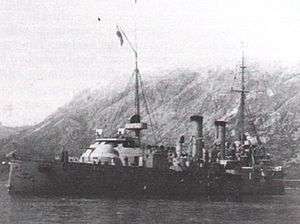SMS Kaiser Franz Joseph I
 | |
| History | |
|---|---|
| Name: | SMS Kaiser Franz Joseph I |
| Builder: | Stabilimento Tecnico Triestino |
| Launched: | 18 May 1889 |
| General characteristics | |
| Class and type: | Kaiser Franz Joseph I-class protected cruiser |
| Displacement: |
|
| Length: | 113.7 m (373.0 ft) |
| Beam: | 16.25 m (53.3 ft) |
| Draft: | 6.81 m (22.3 ft) |
| Propulsion: |
|
| Speed: | 19.35 knots (36 km/h; 22 mph) |
| Complement: | 475 |
| Armament: |
|
| Armor: |
|
SMS Kaiser Franz Josef I was a protected cruiser of the Austro-Hungarian Navy , the lead ship of the Kaiser Franz Joseph I class. Named in honor of the Emperor Franz Josef I of Austria-Hungary, the cruiser and its sister ship, Kaiserin Elisabeth, were built as a reply to the Italian cruisers Giovanni Bausan (1883) and Etna (1885).
Description and construction
Built by Stabilimento Tecnico Triestino at Trieste, Kaiser Franz Josef I was a steel-hulled vessel of 3,967 tons displacement, she measured 321 feet (98 m) in waterline length with a beam of 49 feet (15 m) and a mean draft of 19 feet (5.8 m). The crew comprised 450 officers and men.
Propulsion was supplied by two sets of horizontal triple-expansion engines with four cylindrical double-ended boilers. Designed performance was 6,400 horsepower (4,800 kW) for 18 knots (33 km/h) and 8,000 horsepower (6,000 kW) for 19 knots (35 km/h); on trials she in fact reached 20 knots (37 km/h).
Originally, Kaiser Franz Josef I and Kaiserin Elisabeth were each armed with two 9.4-inch (240 mm) and six 6-inch (150 mm) guns, both types Model 1886. Kaiser Franz Josef I's 9.4-inch guns were mounted in fore and aft turrets, but owing to fiscal constraints those of Kaiserin Elisabeth had armored hoods instead. Both were reconstructed in 1905-06 with each rearmed with two long-barreled 150 mm (6 in) and six short-barreled 150 mm guns, both types Model 1901. Rounding out the armament of each were sixteen 47 mm (1.9 in) quick-firing guns, one machine gun and four 14-inch (360 mm) torpedo tubes located above water, two on either beam.
Service history

Although Kaiser Franz Josef I burned enormous amounts of coal, in 1914 she could still steam at a very fair speed. At the outbreak of the First World War, Kaiser Franz Josef I was serving with the 2nd Cruiser Division. She took part in the shelling of enemy batteries on Mount Lovčen (which dominated Cattaro Bay) on 9 September 1914 and again on 8/9 January 1916. Later she was assigned to subsidiary local defense service at Cattaro. She was disarmed in 1917 for use as a floating headquarters.[1]
Upon the defeat and dissolution of the Austro-Hungarian Empire, Kaiser Franz Josef I was allocated to France as a war reparation. On her delivery voyage, however, she was overloaded with dismantled machinery and foundered in a gale off Kumbor in Cattaro Bay on 17 October 1919.
Portions of the wreck were recovered by a Dutch company in 1922 and by Yugoslav salvagers in 1967.[2]
Notes
References
- Greger, René (1976). Austro-Hungarian Warships of World War I. London: Ian Allan. ISBN 0-7110-0623-7.
- Gogg, Karl. Österreichische Kriegsmarine 1848-1918, Salzburg, 1967,
- Barovič, Jože. Mornarica dvojne monarhije v I. svetovni vojni, Maribor 2005, COBISS 2022207